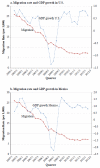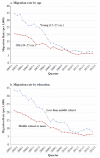Explaining the decline in Mexico-U.S. Migration: the effect of the Great Recession
- PMID: 25407844
- PMCID: PMC4252712
- DOI: 10.1007/s13524-014-0351-4
Explaining the decline in Mexico-U.S. Migration: the effect of the Great Recession
Abstract
The rate of Mexico-U.S. migration has declined precipitously in recent years. From 25 migrants per thousand in 2005, the annual international migration rate for Mexican men dropped to 7 per thousand by 2012. If sustained, this low migration rate is likely to have a profound effect on the ethnic and national-origin composition of the U.S. population. This study examines the origins of the migration decline using a nationally representative panel survey of Mexican households. The results support an explanation that attributes a large part of the decline to lower labor demand for Mexican immigrants in the United States. Decreases in labor demand in industrial sectors that employ a large percentage of Mexican-born workers, such as construction, are found to be strongly associated with lower rates of migration for Mexican men. Second, changes in migrant selectivity are also consistent with an economic explanation for the decline in international migration. The largest declines in migration occurred precisely among the demographic groups most affected by the Great Recession: namely, economically active young men with low education. Results from the statistical analysis also show that the reduction in labor demand in key sectors of the U.S. economy resulted in a more positive educational selectivity of young migrants.
Figures




References
-
- Amnesty International . Invisible victims: Migrants on the move in Mexico. Amnesty International Publications; London, UK: 2010.
-
- Bell DNF, Blanchflower DG. Young people and the great recession. Oxford Review of Economic Policy. 2011;27:241–267.
-
- Borjas GJ. The economic analysis of immigration. In: Ashenfelter OC, Card D, editors. Handbook of labor economics. Elsevier; Amsterdam, The Netherlands: 1999. pp. 1697–1760.
-
- Business Cycle Dating Committee, National Bureau of Economic Research (NBER) Determination of the December 2007 peak in economic activity. NBER; Cambridge, MA: 2008. Report. Retrieved from http://www.nber.org/cycles/dec2008.html.
-
- Cerrutti M, Massey DS. On the auspices of female migration from Mexico to the United States. Demography. 2001;38:187–200. - PubMed
Publication types
MeSH terms
Grants and funding
LinkOut - more resources
Full Text Sources
Other Literature Sources

